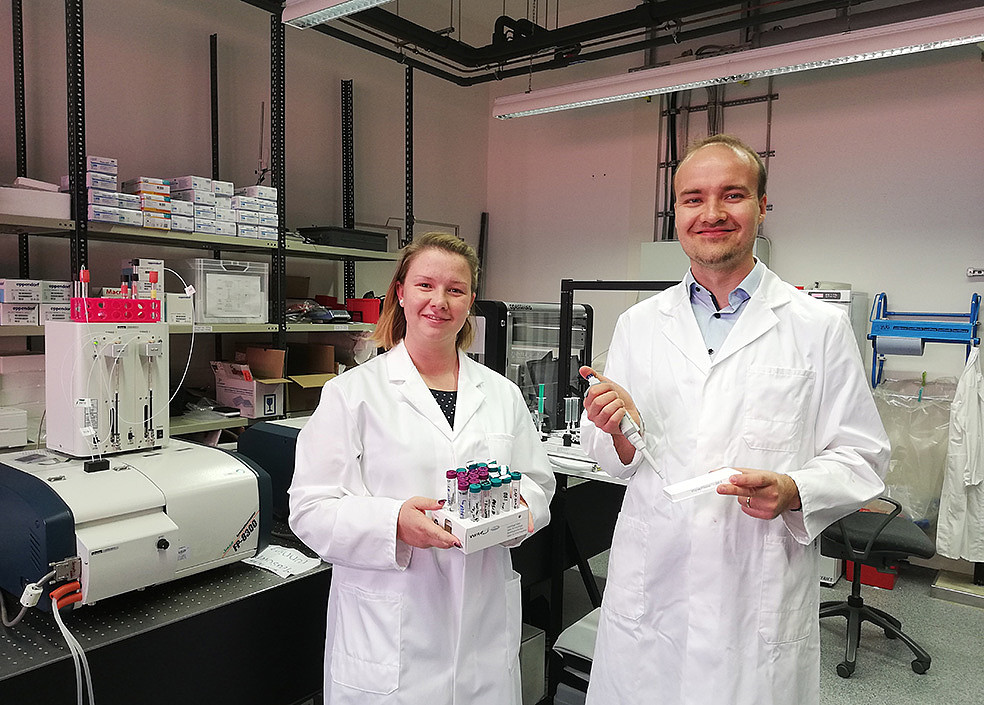Published on November 03, 2020
Asked #3: Nominees of the NEULAND Innovation Contest
* The order in which the short interviews are published is not an indication of placement in the contest.

What motivated you to participate in the NEULAND Innovation Contest?
Laura Grimm: For us, the innovation contest is a great opportunity to present our project and get a first feedback on how it is seen by others and whether it is conclusive for them or not. We have received positive feedback and we are very happy about that.
What do you want to achieve or improve with your technology?
Dr. Frank Biedermann: We want to further develop the sensor technology of neurotransmitters so that they can also be used at home. Existing methods cannot achieve this because laboratory diagnostics are always needed in the end. Ideally, patients should be able to test their neurotransmitter levels themselves, so that people suffering from depression, for example, can adjust their medication dose as needed without having to go through the laboratory diagnostic process. Furthermore, neurotransmitters can be used to discover some specific diseases that would otherwise not be tested for financial reasons. These include random findings such as tumors, which would be conspicuous by a strongly increased neurotransmitter level.
Who benefits from your idea?
Laura Grimm: Primarily, people suffering from depression will hopefully benefit from our idea, when it has been successfully put into practice. They can determine the neurotransmitter level for themselves at home in order to adjust their medication appropriately. Furthermore, our idea also addresses cancer patients, which we would like to help due to early detection of the tumor to receive the earliest possible therapy.
Dr. Frank Biedermann: In addition, there are some special applications we can think of, including pharmaceutical essays for enzyme activities. There are certain enzymes that degrade or produce precursors of neurotransmitters. One example is L-Dopa, a drug for people with Parkinson‘s disease. Persons affected are usually on a medicaltherapy, but in some cases the medicine is only partially broken down by bacteria in the gastrointestinal tract, so that the amount of active ingredient that is absorbed by the patient can vary greatly, making it difficult to adjust the drug dose. Our sensor could be used to measure the enzymatic activities and thus determine the presence of the bacteria. This is not only interesting for the treating doctor and his patient, but also for basic research.
What is the current status of your technology development - what has changed since the submission?
Laura Grimm: We have filed a patent for the sensor material, which has been approved. In addition, we have submitted our project successfully to the Vector Foundation, which supports us with funding for further development. Furthermore, we have contacted various founders to get an idea of the necessary steps for a spin-off. Our invention is user-oriented and offers a good opportunity for a spin-off. Last but not least, I am currently writing a publication on sensor material.
What are the next steps in development?
Dr. Frank Biedermann: We are planning further material developments, especially in cooperation with the working group of Prof. Luisa De Cola (KIT and Milan) to transfer the concept to other analytes.
Laura Grimm: In addition, we would like to further develop the spray pressure method together with the research group of Prof. Lemmer at KIT. Then we would like to achieve immobilization for our sensor, for example by placing it in a gel. Our biggest goal definitely is the spin-off.
The interview was conducted by Marie Simon.

comments about this article
No comments